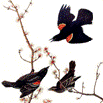Center, Internet, Wildlife Damage Management

Bird Control Seminars Proceedings
Document Type
Article
Date of this Version
October 1973
Abstract
Over 20,000 acres of highbush (cultivated) blueberries are grown in the United States (Johnston et al. 1969). The major producing states are Michigan, New Jersey, North Carolina, Washington, Indiana, and Oregon. Bird damage to blueberries is widespread and sometimes severe (Vaile and Moore, 1968; Pearson, 1958; Hayne and Cardinell, 1949; and Schwartze and Alcorn, 1960). Unfortunately, accurate estimates of less from birds are lacking. Non-lethal methods of controlling bird damage are essential since much of the damage is caused by popular song birds protected by Federal law. Scare devices, including exploders and electronic broadcast alarms, are often used with variable effectiveness. Netting provides the best protection, but the high cost (over $100/acre/year) prohibits its use except for small plantings. The use of low- or nonresidue repellents is a promising approach for non-lethal control of bird damage to agricultural crops. One such chemical (methiocarb [3,5-methyl-4-(Methylthio) phenol methylcarbamate]) has been effective in repelling birds from sprouting corn and ripening sorghum, rice, cherries, and grapes (Guarino, 1972). Promising results have also been achieved in a field test of methiocarb on highbush blueberries in Michigan (Stone et al. 1972) in which a latex sticker was added to the spray solution to increase chemical retention on the fruit. Chemargo Division of Baychem Corporation* is interested in registering methiocarb as an insecticide applied to blueberries without the addition of a sticker. It would be a boon to growers if methiocarb, applied to blueberries as an insecticide, would also significantly reduce bird damage. Thus, the primary objective of our test was to determine the efficacy of methiocarb as a bird repellent when applied under conditions required for its registration as an insecticide (i.e., sans sticker and at a rate of 1 lb. active ingredient per 25 gal. of spray at 50 gal./acre, with a 14-day delay between application and harvest). A secondary objective was to obtain information on the species of birds feeding on blueberries and their behavior.

